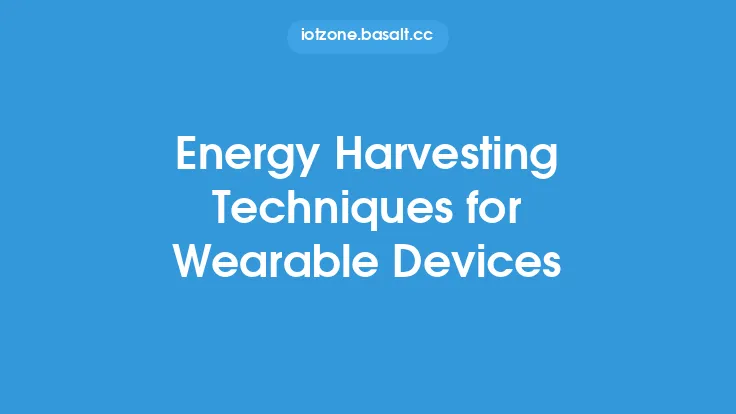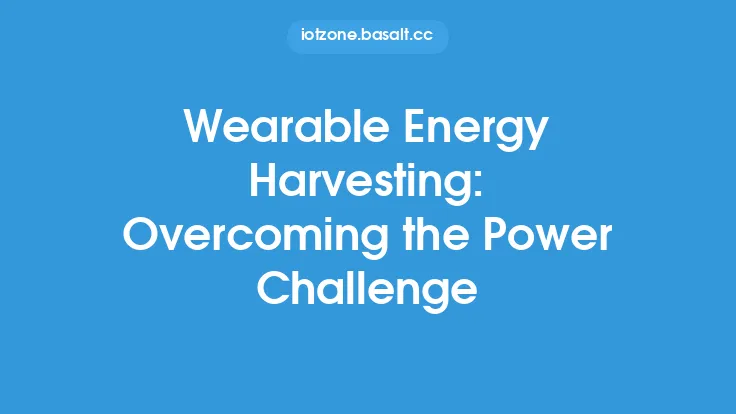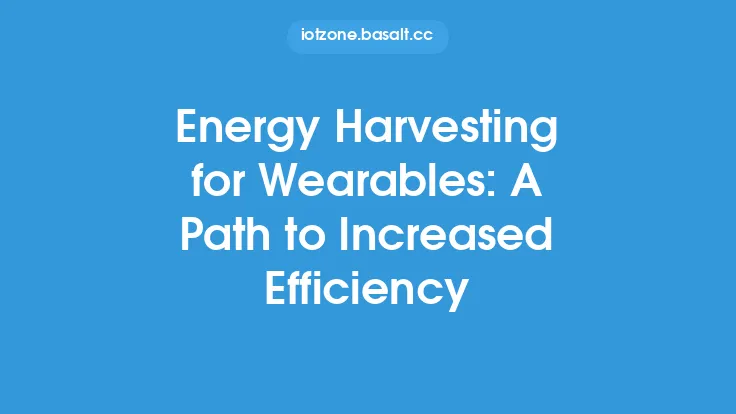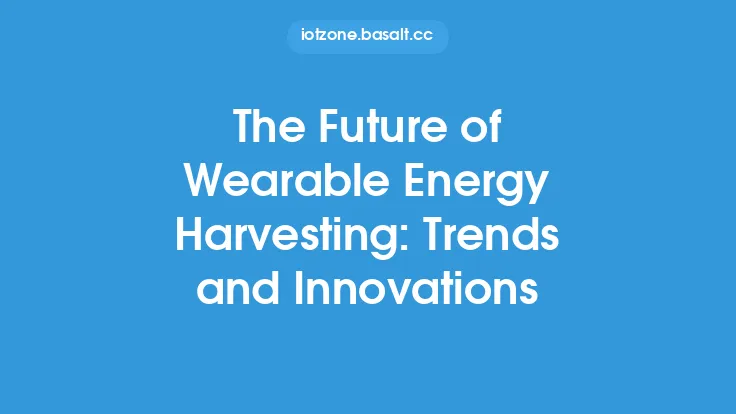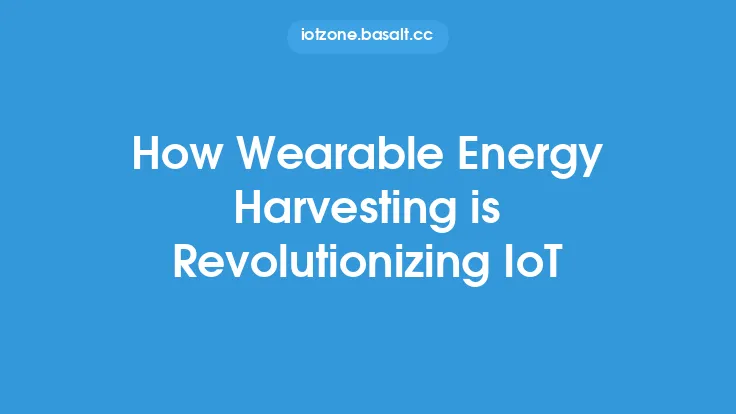The concept of wearable energy harvesting has been gaining significant attention in recent years, particularly with the growing demand for Internet of Things (IoT) devices. Wearable technology has become an integral part of our daily lives, from smartwatches and fitness trackers to smart glasses and hearing aids. However, one of the major challenges associated with these devices is their limited battery life, which can be a significant hindrance to their widespread adoption. This is where wearable energy harvesting comes into play, enabling endless power for IoT devices and revolutionizing the way we interact with wearable technology.
Introduction to Wearable Energy Harvesting
Wearable energy harvesting refers to the process of capturing and converting ambient energy into electrical energy, which can be used to power wearable devices. This technology has the potential to eliminate the need for batteries or reduce the frequency of recharging, making wearable devices more convenient, sustainable, and reliable. There are several types of energy harvesting technologies that can be used for wearable devices, including solar, thermal, kinetic, and electromagnetic energy harvesting. Each of these technologies has its own advantages and disadvantages, and the choice of technology depends on the specific application and requirements of the wearable device.
Types of Wearable Energy Harvesting Technologies
Solar energy harvesting is one of the most common types of energy harvesting technologies used for wearable devices. It involves the use of photovoltaic cells to convert sunlight into electrical energy. Solar energy harvesting is particularly useful for wearable devices that are exposed to sunlight for extended periods, such as smart glasses or smartwatches. However, solar energy harvesting can be limited by the amount of sunlight available, and it may not be suitable for devices that are used indoors or in low-light environments.
Thermal energy harvesting, on the other hand, involves the use of thermoelectric materials to convert heat into electrical energy. This technology is particularly useful for wearable devices that are in close proximity to the human body, such as smart clothing or wearable sensors. Thermal energy harvesting can provide a reliable source of power for devices that are used for extended periods, and it can be used to power devices that require low levels of power.
Kinetic energy harvesting involves the use of piezoelectric materials to convert mechanical energy into electrical energy. This technology is particularly useful for wearable devices that are subject to mechanical stress or vibration, such as smart shoes or wearable sensors. Kinetic energy harvesting can provide a reliable source of power for devices that are used in high-motion environments, and it can be used to power devices that require low levels of power.
Electromagnetic energy harvesting involves the use of antennas or coils to capture electromagnetic radiation and convert it into electrical energy. This technology is particularly useful for wearable devices that are used in environments with high levels of electromagnetic radiation, such as near cellular base stations or Wi-Fi routers. Electromagnetic energy harvesting can provide a reliable source of power for devices that are used for extended periods, and it can be used to power devices that require low levels of power.
Wearable Energy Harvesting Systems
A wearable energy harvesting system typically consists of several components, including an energy harvesting device, a power management system, and a storage device. The energy harvesting device is responsible for capturing and converting ambient energy into electrical energy. The power management system is responsible for regulating the flow of energy and ensuring that the device is powered efficiently. The storage device is responsible for storing excess energy for later use.
The design of a wearable energy harvesting system depends on the specific application and requirements of the wearable device. For example, a wearable device that requires high levels of power may require a more advanced power management system and a larger storage device. On the other hand, a wearable device that requires low levels of power may be able to use a simpler power management system and a smaller storage device.
Applications of Wearable Energy Harvesting
Wearable energy harvesting has a wide range of applications, from consumer electronics to medical devices. One of the most significant applications of wearable energy harvesting is in the field of IoT devices. IoT devices are designed to be small, low-power, and wireless, making them ideal candidates for wearable energy harvesting. Wearable energy harvesting can provide a reliable source of power for IoT devices, eliminating the need for batteries or reducing the frequency of recharging.
Wearable energy harvesting also has significant applications in the field of medical devices. Medical devices, such as pacemakers and implantable cardioverter-defibrillators, require a reliable source of power to function properly. Wearable energy harvesting can provide a reliable source of power for these devices, eliminating the need for batteries or reducing the frequency of recharging.
Challenges and Limitations of Wearable Energy Harvesting
Despite the significant advantages of wearable energy harvesting, there are several challenges and limitations associated with this technology. One of the major challenges is the limited amount of energy that can be harvested from ambient sources. This can make it difficult to power devices that require high levels of power, and it can limit the widespread adoption of wearable energy harvesting technology.
Another challenge associated with wearable energy harvesting is the efficiency of the energy harvesting device. The efficiency of the energy harvesting device can have a significant impact on the overall performance of the wearable energy harvesting system, and it can affect the amount of energy that can be harvested from ambient sources.
Future Directions of Wearable Energy Harvesting
The future of wearable energy harvesting is promising, with significant advancements being made in the field of energy harvesting technologies. One of the most significant areas of research is in the development of new energy harvesting materials and technologies. These materials and technologies have the potential to increase the efficiency of energy harvesting devices and provide a reliable source of power for wearable devices.
Another area of research is in the development of advanced power management systems. These systems can help to regulate the flow of energy and ensure that wearable devices are powered efficiently. Advanced power management systems can also help to reduce the amount of energy that is wasted, and they can increase the overall performance of the wearable energy harvesting system.
Conclusion
Wearable energy harvesting is a promising technology that has the potential to revolutionize the way we interact with wearable devices. By providing a reliable source of power, wearable energy harvesting can eliminate the need for batteries or reduce the frequency of recharging, making wearable devices more convenient, sustainable, and reliable. While there are several challenges and limitations associated with wearable energy harvesting, the future of this technology is promising, with significant advancements being made in the field of energy harvesting technologies and power management systems. As research and development continue to advance, we can expect to see widespread adoption of wearable energy harvesting technology in a wide range of applications, from consumer electronics to medical devices.
